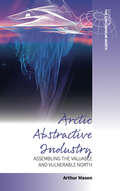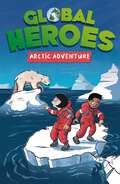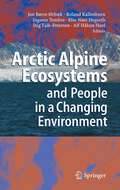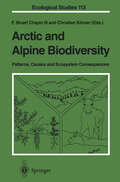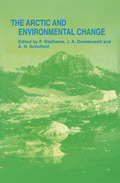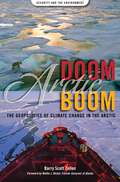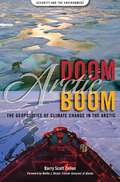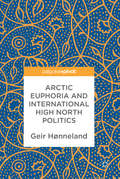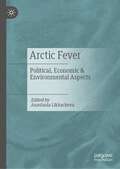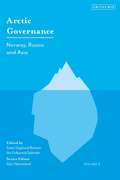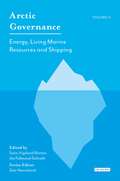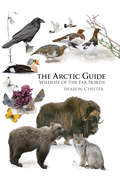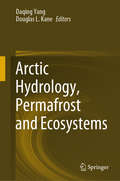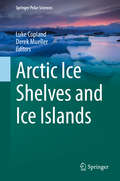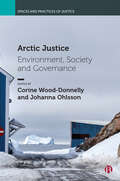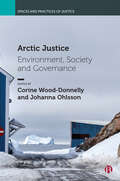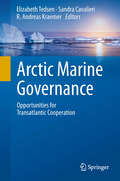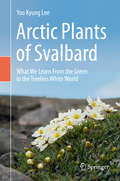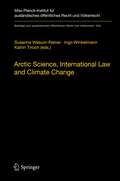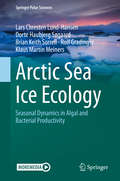- Table View
- List View
Arctic Abstractive Industry: Assembling the Valuable and Vulnerable North (Studies in the Circumpolar North #5)
by Arthur MasonThrough diverse engagements with natural resource extraction and ecological vulnerability in the contemporary Arctic, contributors to this volume apprehend Arctic resource regimes through the concept of abstraction. Abstraction refers to the creation of new material substances and cultural values by detaching parts from existing substances and values. The abstractive process differs from the activity of extractive industries by its focus on the conceptual resources that conceal processes of exploitation associated with extraction. The study of abstraction can thus help us attune to the formal operations that make appropriations of value possible while disclosing the politics of extraction and of its representation.
Arctic Adventure (Global Heroes #4)
by Damian HarveyJoin our team of Global Heroes in this fast-paced, science-themed chapter book set in the abominably cold arctic!Great for readers age 7+ these adventure stories are also full of fascinating facts. These illustrated chapter books are perfect for making fascinating science topics accessible to young readers, inspiring a thirst for knowledge and learning by stealth. The team of characters come from around the world to give a truly global outlook.
Arctic Alpine Ecosystems and People in a Changing Environment
by Ingunn Tombre Else N. Hegseth Stig Falk-Petersen Alf H. Hoel Jon Børre Ørbaek Roland KallenbornThe European Arctic and Alpine regions are experiencing large environmental changes. These changes may have socio-economic effects if the changes affect the bioproduction, which form the basis for the marine and terrestrial food chains. This uniquely multidisciplinary book presents the various aspects of contemporary environmental changes in Arctic and Alpine Regions.
Arctic and Alpine Biodiversity: Patterns, Causes and Ecosystem Consequences (Ecological Studies #113)
by F. Stuart Iii Chapin Christian KörnerAs human populations expand and have increasing access to technol ogy, two general environmental concerns have arisen. First, human pop ulations are having increasing impact on the earth system, such that we are altering the biospheric carbon pools, basic processes of elemental cycling and the climate system of the earth. Because of time lags and feedbacks, these processes are not easily reversed. These alterations are occurring now more rapidly than at any time in the last several million years. Secondly, human activities are causing changes in the earth's biota that lead to species extinctions at a rate and magnitude rivaling those of past geologic extinction events. Although environmental change is potentially reversible at some time scales, the loss of species is irrevo cable. Changes in diversity at other scales are also cause for concern. Habitat fragmentation and declines in population sizes alter genetic di versity. Loss or introduction of new functional groups, such as nitro gen fixers or rodents onto islands can strongly alter ecosystem processes. Changes in landscape diversity through habitat modification and frag mentation alter the nature of processes within and among vegetation patches. Although both ecological changes altering the earth system and the loss of biotic diversity have been major sources of concern in recent years, these concerns have been largely independent, with little concern for the environmental causes the ecosystem consequences of changes in biodiversity. These two processes are clearly interrelated. Changes in ecological systems cause changes in diversity.
Arctic and Environmental Change
by J. A. DowdeswellThis timely book presents a wide-ranging review of Arctic environmental change in response to global warming, and gives a broad insight into the transformation of the Arctic which we can expect during the next century. It is in high northern latitudes that we can expect to observe global warming at its most powerful, making it a natural laboratory where climate changes and their impacts can be monitored and studied more readily than elsewhere in the world. Fourteen authoritative reviews cover the predictions of warming rates by General Circulation Models; variabilities in atmospheric circulation and moisture flux; the dynamics of the polar vortex in the Arctic and its role in ozone loss; the countervailing influence of air pollution in reducing solar irradiance; and the impact of climatic change on Arctic terrestrial and marine ecosystems. Also detailed are the thermohaline circulation of the ocean, the extent and thickness of sea ice, the sizes of glaciers and ice sheets, and the extent of permafrost. Moving to past changes, the records from Greenland ice cores and deep ocean drilling are reviewed for what they tell us about past climates and glaciation in the Arctic., The book paints a vivid and disturbing picture of the enhanced warming that can be expected in the Arctic relative to lower latitudes, and of the major impacts that this will have on the northern cryosphere. It will be an invaluable reference for anyone seeking a greater understanding of the factors and processes affecting the arctic environment, which may ultimately have a major impact on global climatic change.
Arctic and Environmental Change
by J. A. DowdeswellThis timely book presents a wide-ranging review of Arctic environmental change in response to global warming, and gives a broad insight into the transformation of the Arctic which we can expect during the next century. It is in high northern latitudes that we can expect to observe global warming at its most powerful, making it a natural laboratory where climate changes and their impacts can be monitored and studied more readily than elsewhere in the world. Fourteen authoritative reviews cover the predictions of warming rates by General Circulation Models; variabilities in atmospheric circulation and moisture flux; the dynamics of the polar vortex in the Arctic and its role in ozone loss; the countervailing influence of air pollution in reducing solar irradiance; and the impact of climatic change on Arctic terrestrial and marine ecosystems. Also detailed are the thermohaline circulation of the ocean, the extent and thickness of sea ice, the sizes of glaciers and ice sheets, and the extent of permafrost. Moving to past changes, the records from Greenland ice cores and deep ocean drilling are reviewed for what they tell us about past climates and glaciation in the Arctic., The book paints a vivid and disturbing picture of the enhanced warming that can be expected in the Arctic relative to lower latitudes, and of the major impacts that this will have on the northern cryosphere. It will be an invaluable reference for anyone seeking a greater understanding of the factors and processes affecting the arctic environment, which may ultimately have a major impact on global climatic change.
The Arctic Council: Between Environmental Protection and Geopolitics
by Svein Vigeland RottemThis pivot introduces the Arctic Council and its role as a platform for dealing with local, national, regional and global challenges of relevance to the “new” Arctic. Against the backdrop of climate change and increasing commercial activity, it considers what a future Arctic should look like, from ideas of total protection to expansive oil and gas extraction. It examines the Arctic’s position on the political agenda, from Norway’s High North hype to a more peripheral place in the foreign policy of the US and explores the Council's role as an important international forum for dialogue and cooperation on Arctic challenges and opportunities, and a significant arena for developing knowledge and learning about a changing region.
Arctic Doom, Arctic Boom: The Geopolitics of Climate Change in the Arctic (Security and the Environment)
by Barry Scott ZellenAn expert examination of the way climate change is transforming the Arctic environmentally, economically, and geopolitically, and how the challenges of that transformation should be met.A growing number of scientists estimate that there will be no summer ice in the Arctic by as soon as 2013. Are we approaching the "End of the Arctic?" as journalist Ed Struzik asked in 1992, or fully entering the "Age of the Arctic," as Arctic expert Oran Young predicted in 1986? Arctic Doom, Arctic Boom: The Geopolitics of Climate Change in the Arctic looks at the uncertainty at the top of the world as the shrinking of the polar ice cap opens up new sea lanes and the vast hydrocarbon riches of the Arctic seafloor to commercial development and creates environmental disasters for Arctic biota and indigenous peoples. Arctic Doom, Arctic Boom explores the geopolitics of the Arctic from a historical as well as a contemporary perspective, showing how the warming of the Earth is transforming our very conception of the Arctic. In addition to addressing economic and environmental issues, the book also considers the vital strategic role of the region in our nation's defenses.
Arctic Doom, Arctic Boom: The Geopolitics of Climate Change in the Arctic (Security and the Environment)
by Dr. Barry Scott ZellenAn expert examination of the way climate change is transforming the Arctic environmentally, economically, and geopolitically, and how the challenges of that transformation should be met.A growing number of scientists estimate that there will be no summer ice in the Arctic by as soon as 2013. Are we approaching the "End of the Arctic?" as journalist Ed Struzik asked in 1992, or fully entering the "Age of the Arctic," as Arctic expert Oran Young predicted in 1986? Arctic Doom, Arctic Boom: The Geopolitics of Climate Change in the Arctic looks at the uncertainty at the top of the world as the shrinking of the polar ice cap opens up new sea lanes and the vast hydrocarbon riches of the Arctic seafloor to commercial development and creates environmental disasters for Arctic biota and indigenous peoples. Arctic Doom, Arctic Boom explores the geopolitics of the Arctic from a historical as well as a contemporary perspective, showing how the warming of the Earth is transforming our very conception of the Arctic. In addition to addressing economic and environmental issues, the book also considers the vital strategic role of the region in our nation's defenses.
Arctic Euphoria and International High North Politics
by Geir HønnelandThis pivot describes the ups and downs of Norwegian High North politics since the end of the Cold War. It considers how political interest in the Arctic has been growing rapidly in the international community as states stake their claim to areas of the continental shelf in the Arctic Ocean, and focuses on Russia’s actions, as the Arctic state with the longest shoreline and the only one outside NATO. The author argues that among the Western countries, Norway has the most extensive experience in tackling Russia in the Arctic, and the neighbourhood with the Russian Bear invariably shapes foreign policy, notably in matters of security, and how foreign policy concerns are intertwined with economic motives, be that hopes of access to the big Russian market or to the oil and gas fields on the Russian Arctic shelf. To achieve the combined goal of security and business, the Norwegian Government has regularly orchestrated “Arctic waves” to direct the attention of local, national and international politicians and businesses to the alleged opportunities of the North. In this book, the author takes us through “the Great Barents Awakening” of the 1990s, “the Great High North Enchantment” of the early 2000s and recent years’ “Arctic wave” in Norwegian foreign policy.
Arctic Euphoria and International High North Politics
by Geir HønnelandThis pivot describes the ups and downs of Norwegian High North politics since the end of the Cold War. It considers how political interest in the Arctic has been growing rapidly in the international community as states stake their claim to areas of the continental shelf in the Arctic Ocean, and focuses on Russia’s actions, as the Arctic state with the longest shoreline and the only one outside NATO. The author argues that among the Western countries, Norway has the most extensive experience in tackling Russia in the Arctic, and the neighbourhood with the Russian Bear invariably shapes foreign policy, notably in matters of security, and how foreign policy concerns are intertwined with economic motives, be that hopes of access to the big Russian market or to the oil and gas fields on the Russian Arctic shelf. To achieve the combined goal of security and business, the Norwegian Government has regularly orchestrated “Arctic waves” to direct the attention of local, national and international politicians and businesses to the alleged opportunities of the North. In this book, the author takes us through “the Great Barents Awakening” of the 1990s, “the Great High North Enchantment” of the early 2000s and recent years’ “Arctic wave” in Norwegian foreign policy.
Arctic Fever: Political, Economic & Environmental Aspects
by Anastasia LikhachevaThis book explores the Arctic as a rapidly evolving phenomenon in international affairs of a rising number of stakeholders. For decades, Arctic studies used to be an affair of a relatively narrow group of experts from northern countries. This time is over due to a new Chinese Arctic policy, as well as growing regional interests from South Korea, Singapore, India and Japan. Contributors reflect on new roles for the Arctic region: both as a playground for the old school nation state competition and even confrontation, and a new source for international cooperation in energy, logistics and natural sciences. Climate change, political tensions and economic competition make Arctic a hotter venue of international relations. This new Arctic fever, studied through a comparative analysis of different regional agendas, especially with a focus on the US–China–Russia triangle, represents the main subject of our book, which will be of interest to scholars of geopolitics, of climate change, and of 21st century energy economics.
Arctic Governance: Norway, Russia and Asia (Arctic Governance)
by Svein Vigeland Rottem Ida Folkestad SoltvedtThe Polar North is known to be home to large gas and oil reserves and its position holds significant trading and military advantages, yet the maritime boundaries of the region remain ill-defined. In the twenty-first century the Arctic is undergoing profound change. As the sea ice melts, a result of accelerating climate change, global governance has become vital. In this, the third of three volumes, the latest research and analysis from the world's leading Arctic research body - the Fridtjof Nansen Institute - is brought together for the first time. Arctic Governance: Norway, Russia and Asia investigates the foreign policy discourses of Arctic governance, specifically as regarding international relations and competing interests between Norway, Russia and various Asian states.
Arctic Governance: Energy, Living Marine Resources and Shipping (Arctic Governance Ser.)
by Ida Folkestad Soltvedt Svein Vigeland Rottem Geir HønnelandThe Polar North is known to be home to large gas and oil reserves and its position holds significant trading and military advantages, yet the maritime boundaries of the region remain ill-defined. In the twenty-first century the Arctic is undergoing profound change. As the sea ice melts, a result of accelerating climate change, global governance has become vital. In this first of three volumes, the latest research and analysis from the Fridtjof Nansen Institute, the world's leading Arctic research body, is brought together. Arctic Governance: Law and Politics investigates the legal and political order of the Polar North, focusing on governance structures and the Law of the Sea. Are the current mechanisms at work effective? Are the Arctic states' interests really clashing, or is the atmosphere of a more cooperative nature? Skilfully delineating policy in the region and analysing the consequences of treaty agreements, Arctic Governance's uncovering of a rather orderly 'Arctic race' will become an indispensable contribution to contemporary International Relations concerning the Polar North.
Arctic Governance: Norway, Russia and Asia (Arctic Governance)
The Polar North is known to be home to large gas and oil reserves and its position holds significant trading and military advantages, yet the maritime boundaries of the region remain ill-defined. In the twenty-first century the Arctic is undergoing profound change. As the sea ice melts, a result of accelerating climate change, global governance has become vital. In this, the third of three volumes, the latest research and analysis from the world's leading Arctic research body - the Fridtjof Nansen Institute - is brought together for the first time. Arctic Governance: Norway, Russia and Asia investigates the foreign policy discourses of Arctic governance, specifically as regarding international relations and competing interests between Norway, Russia and various Asian states.
The Arctic Guide: Wildlife of the Far North
by Sharon ChesterThe Arctic Guide presents the traveler and naturalist with a portable, authoritative guide to the flora and fauna of earth's northernmost region. Featuring superb color illustrations, this one-of-a-kind book covers the complete spectrum of wildlife—more than 800 species of plants, fishes, butterflies, birds, and mammals—that inhabit the Arctic’s polar deserts, tundra, taiga, sea ice, and oceans. It can be used anywhere in the entire Holarctic region, including Norway’s Svalbard archipelago, Siberia, the Russian Far East, islands of the Bering Sea, Alaska, the Canadian Arctic, and Greenland. Detailed species accounts describe key identification features, size, habitat, range, scientific name, and the unique characteristics that enable these organisms to survive in the extreme conditions of the Far North. A color distribution map accompanies each species account, and alternative names in German, French, Norwegian, Russian, Inuit, and Inupiaq are also provided. Features superb color plates that allow for quick identification of more than 800 species of plants, fishes, butterflies, birds, and mammals Includes detailed species accounts and color distribution maps Covers the flora and fauna of the entire Arctic region
The Arctic Guide: Wildlife of the Far North
by Sharon ChesterThe Arctic Guide presents the traveler and naturalist with a portable, authoritative guide to the flora and fauna of earth's northernmost region. Featuring superb color illustrations, this one-of-a-kind book covers the complete spectrum of wildlife—more than 800 species of plants, fishes, butterflies, birds, and mammals—that inhabit the Arctic’s polar deserts, tundra, taiga, sea ice, and oceans. It can be used anywhere in the entire Holarctic region, including Norway’s Svalbard archipelago, Siberia, the Russian Far East, islands of the Bering Sea, Alaska, the Canadian Arctic, and Greenland. Detailed species accounts describe key identification features, size, habitat, range, scientific name, and the unique characteristics that enable these organisms to survive in the extreme conditions of the Far North. A color distribution map accompanies each species account, and alternative names in German, French, Norwegian, Russian, Inuit, and Inupiaq are also provided. Features superb color plates that allow for quick identification of more than 800 species of plants, fishes, butterflies, birds, and mammals Includes detailed species accounts and color distribution maps Covers the flora and fauna of the entire Arctic region
Arctic Hydrology, Permafrost and Ecosystems
by Daqing Yang Douglas L. KaneThis book provides a comprehensive, up-to-date assessment of the key terrestrial components of the Arctic system, i.e., its hydrology, permafrost, and ecology, drawing on the latest research results from across the circumpolar regions. The Arctic is an integrated system, the elements of which are closely linked by the atmosphere, ocean, and land. Using an integrated system approach, the book’s 30 chapters, written by a diverse team of leading scholars, carefully examine Arctic climate variability/change, large river hydrology, lakes and wetlands, snow cover and ice processes, permafrost characteristics, vegetation/landscape changes, and the future trajectory of Arctic system evolution. The discussions cover the fundamental features of and processes in the Arctic system, with a special focus on critical knowledge gaps, i.e., the interactions and feedbacks between water, permafrost, and ecosystem, such as snow pack and permafrost changes and their impacts on basin hydrology and ecology, river flow, geochemistry, and energy fluxes to the Arctic Ocean, and the structure and function of the Arctic ecosystem in response to past/future changes in climate, hydrology, and permafrost conditions. Given its scope, the book offers a valuable resource for researchers, graduate students, environmentalists, managers, and administrators who are concerned with the northern environment and resources.
Arctic Ice Shelves and Ice Islands (Springer Polar Sciences)
by Luke Copland Derek MuellerThis book provides an overview of the current state of knowledge of Arctic ice shelves, ice islands and related features. Ice shelves are permanent areas of ice which float on the ocean surface while attached to the coast, and typically occur in very cold environments where perennial sea ice builds up to great thickness, and/or where glaciers flow off the land and are preserved on the ocean surface. These landscape features are relatively poorly studied in the Arctic, yet they are potentially highly sensitive indicators of climate change because they respond to changes in atmospheric, oceanic and glaciological conditions. Recent fracturing and breakup events of ice shelves in the Canadian High Arctic have attracted significant scientific and public attention, and produced large ice islands which may pose a risk to Arctic shipping and offshore infrastructure. Much has been published about Antarctic ice shelves, but to date there has not been a dedicated book about Arctic ice shelves or ice islands. This book fills that gap.
Arctic Justice: Environment, Society and Governance
by Corine Wood-Donnelly and Johanna OhlssonEPDF and EPUB available Open Access under CC-BY-NC-ND licence. Offering a unique introduction to the study of justice in the European, North American and Russian Arctic, this collection considers the responsibilities and failures of justice for environment and society in the region. Inspired by key thinkers in justice, this book highlights the real and practical consequences of postcolonial legacies, climate change and the regions’ incorporation into the international political economy. The chapters feature liberal, cosmopolitan, feminist, as well as critical justice perspectives from experts with decades of research experience in the Arctic. Moving from a critique of current failures, the collection champions a just and sustainable future for Arctic development and governance.
Arctic Justice: Environment, Society and Governance
EPDF and EPUB available Open Access under CC-BY-NC-ND licence. Offering a unique introduction to the study of justice in the European, North American and Russian Arctic, this collection considers the responsibilities and failures of justice for environment and society in the region. Inspired by key thinkers in justice, this book highlights the real and practical consequences of postcolonial legacies, climate change and the regions’ incorporation into the international political economy. The chapters feature liberal, cosmopolitan, feminist, as well as critical justice perspectives from experts with decades of research experience in the Arctic. Moving from a critique of current failures, the collection champions a just and sustainable future for Arctic development and governance.
Arctic Marine Governance: Opportunities for Transatlantic Cooperation
by Elizabeth Tedsen Sandra Cavalieri R. Andreas KraemerThe Arctic region plays an important role in regulating the world’s climate and is also highly impacted by climate change, with average temperatures rising almost twice as fast as the rest of the world and sea ice melting much faster than previously predicted. These rapid changes will have significant impacts on human activity in the region and on the Arctic marine environment. This book draws on the results of the 2008-2009 Arctic TRANSFORM project, funded by the European Commission‘s Directorate General of External Relations, which engaged experts in a transatlantic discussion on the roles of the European Union and United States in light of the Arctic’s changing climate and political and legal complexities. . The book addresses the significant changes and developments in the marine Arctic, with descriptions and recommendations reflecting the current governance environment. A comprehensive overview of environmental governance and sustainable development in the Arctic is created. Chapters explore impacts and activities by sector, looking at fisheries, shipping, and offshore hydrocarbon in the Arctic, and at policy options and strategies for improving marine governance in the region. A particular focus is given to the roles of the European Union and United States and opportunities for cooperation to enhance Arctic environmental governance. .
Arctic Plants of Svalbard: What We Learn From the Green in the Treeless White World
by Yoo Kyung LeeThe Arctic is a special world. The Arctic Ocean is covered by white sea ice, and its margins are surrounded by bare terrestrial regions, known as tundra. Tundra is a cold and dry environment without trees, but even in the absence of trees, tundra plants such as dwarf shrubs, grasses, herbs and moss support the harsh environment by providing sustenance and shelter. This book introduces representative arctic plants and their function in Svalbard, revealing the unique tundra ecosystem, and discussing the direct and indirect effects of climate change in the Arctic.
Arctic Science, International Law and Climate Change: Legal Aspects of Marine Science in the Arctic Ocean (Beiträge zum ausländischen öffentlichen Recht und Völkerrecht #235)
by Susanne Wasum-Rainer Ingo Winkelmann Katrin TirochDevelopments in the Arctic region are increasingly part of international discussion. The book contains a comprehensive and interdisciplinary analysis of the current problems around marine scientific research in the Arctic region. It combines scientific, legal and policy aspects. The main questions addressed are: ongoing and future Arctic marine research, marine research in the Arctic Ocean in practice, the legal framework, enlarged continental shelves and the freedom of marine science and particularities and challenges of the Arctic region. The contributors are leading experts in the field of politics, law and science.
Arctic Sea Ice Ecology: Seasonal Dynamics in Algal and Bacterial Productivity (Springer Polar Sciences)
by Lars Chresten Lund-Hansen Dorte Haubjerg Søgaard Brian Keith Sorrell Rolf Gradinger Klaus Martin MeinersThe book on sea ice ecology is the ecology of sea ice algae and other microorganism as bacteria, meiofauna, and viruses residing inside or at the bottom of the sea ice, called the sympagic biota. Organisms as seals, fish, birds, and Polar bears relies on sea ice but are not part of this biota. A distinct feature of this ecosystem, is the disappearance (melt) every summer and re-establishing in autumn and winter. The book is organized seasonally describing the physical, optical, biological, and geochemical conditions typical of the seasons: autumn, winter, and spring. These are exemplified with case studies based on author’s fieldwork in Greenland, the Arctic Ocean, and Antarctica but focused on Arctic conditions. The sea ice ecosystem is described in the context of climate change, interests, and effects of a decreasing summer ice extent in the Arctic Ocean. The book contains an up to date description of most relevant methods and techniques applied in sea ice ecology research.This book will appeal to university students at Masters or PhD levels reading biology, geosciences, and chemistry.
